
The
Bridges of Rome
The locations of all places are shown on my Google-Earth Map
Google-Maps (encrease the magnification this map is in 3-D)
There
are more than 30 new and old bridges crossing the Tiber in Rome, from
Ponte Sublicio (642 BC) to Ponte di Tor di Quinto (1960). There
exists no complete, annotated list of the bridges. I have selected a
few from Wikipedia.
They appear in chronological order.
Ponte Sublicio
The Wooden Bridge:
642 BC

The earliest bridge of ancient Rome, the Pons Sublicius, spanned the Tiber River near the Forum Boarium ("cattle forum") downstream of the Tiber Island, near the foot of the Aventine Hill. According to tradition, its construction was ordered by Ancus Martius around 642 BC, but this date is approximate because there is no ancient record of its construction. Legend tells us that the bridge was made entirely of wood. The name comes from Latin pons sublicius, "resting on pilings."
Ponte Rotto
Pons Aemilius:
241 BC
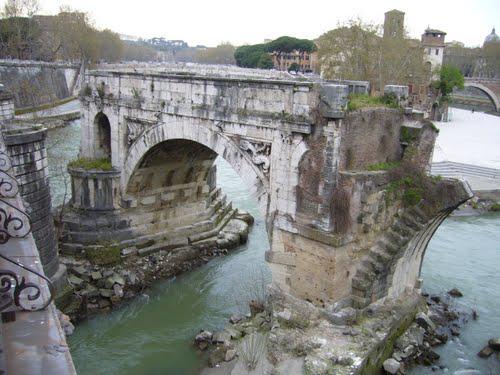
Pons Aemilius (Italian: Ponte Emilio), today called Ponte Rotto, is the oldest Roman stone bridge in Rome, Italy. Preceded by a wooden version, it was rebuilt in stone in the 2nd century BC. It once spanned the Tiber, connecting the Forum Boarium with Trastevere; a single arch in mid-river is all that remains today, lending the bridge its name Ponte rotto ("Broken bridge").
Ponte Milvio
Milvian
Bridge, 206/215 BC
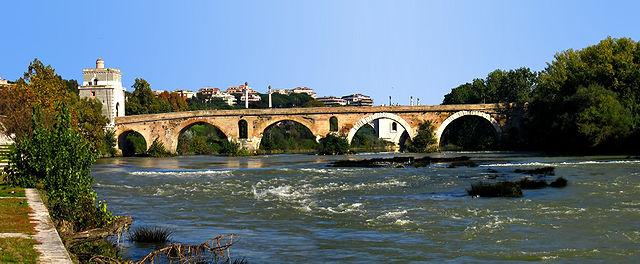
The
Milvian bridge was built by consul Gaius Claudius Nero in 206 BC,
after he had defeated the Carthagian army in the Battle of the
Metaurus. In 115 BC, consul Marcus Aemilius Scaurus built a new
bridge made of stone in the same place and demolishing the old one.
In 63 BC letters from the conspirators of the Catiline conspiracy
were intercepted here allowing Cicero to read them to the Roman
Senate the next day.
In AD 312, Constantine
I, the Great defeated his rival Maxentius between this bridge and
Saxa Rubra, in the Battle of Milvian Bridge in which Constantine had
a vision of Christ.
Ponte Fabricio
Ponte
dei Quattro Capi,
62 BC
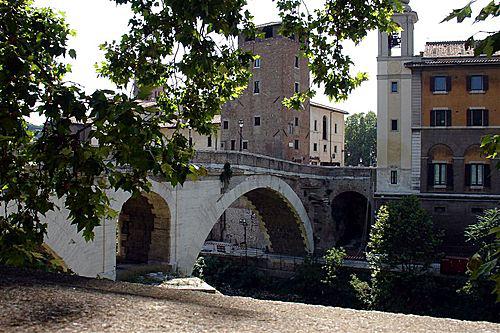
The Pons Fabricius ( Ponte Fabricio) or Ponte dei Quattro Capi, according to Dio Cassius, was built in 62 BC, the year after Cicero was elected consul, to replace an earlier wooden bridge destroyed by fire. It was commissioned by Lucius Fabricius, the curator of the roads and a member of the gens Fabricia of Rome. Completely intact from Roman antiquity, it has been in continuous use ever since.
Ponte Cestio
Bridge
to the Tiber Island, 62
BC -370
AD
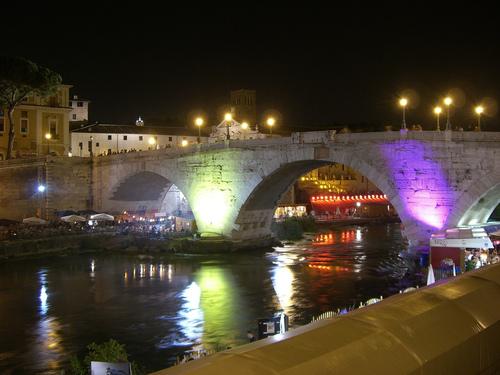
The original version of this bridge was built around the 1st century
BC (some time between 62 and 27 BC), after the Pons Fabricius.
Whereas the island was long connected with the left bank of the Tiber
and the heart of ancient Rome, even before the pons Fabricius, the
right bank (Transtiber) remained unconnected until the Cestius was
constructed. Several prominent members of the Cestii clan from the
1st century BC are known, but it is uncertain which of them built
this bridge.
In the 4th century the Pons Cestius was rebuilt by
Emperors Valentinian I, Valens, and Gratian and rededicated in 370 AD
as the Pons Gratiani. The bridge was rebuilt using tuff and peperino,
with a facing of travertine.
Beware, the area is alive with
pick-pockets at night!
Ponte Sant'Angelo
Pons
Aelius,
134
AD

Ponte Sant'Angelo, once the Pons Aelius, was built 134 AD by Roman
Emperor Hadrian, to span the Tiber, from the city center to his newly
constructed mausoleum, now the towering Castel Sant'Angelo. The
bridge is faced with travertine marble and spans the Tiber with three
arches.
In the seventh century, under Pope Gregory I, both
the castle and the bridge took on the name Sant'Angelo, explained by
a legend that an angel appeared on the roof of the castle to announce
the end of the plague.
During the 1450 jubilee, balustrades of
the bridge yielded, due to the great crowds of the pilgrims, and many
drowned in the river. For centuries after the 16th century, the
bridge was used to expose the bodies of the executed.
Pope
Clement VII allocated the toll income from the bridge to erecting the
statues of the apostles Saint Peter and Paul to which subsequently
the four evangelists and the patriarchs were added to other
representing statues of Adam, Noah, Abraham, and Moses. In 1669 Pope
Clement IX commissioned replacements for the aging stucco angels by
Raffaello da Montelupo. Commissioned by Paul III, Bernini's program,
one of his last large projects, called for ten angels holding
instruments of the Passion: he personally only finished the two
originals of the Angels with the Superscription "I.N.R.I."
and with the Crown of Thorns, but these were kept by Clement IX for
his own pleasure. They are now in the church of Sant'Andrea delle
Fratte in Rome.
Ponte Nomentano
Pons
Lamentanus, 1447–1455
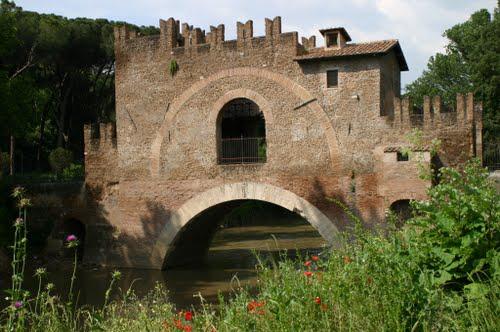
Ponte Nomentano (called Pons Lamentanus in the Middle Ages) carried the Via Nomentana over the Aniene (Latin: Anio) river.
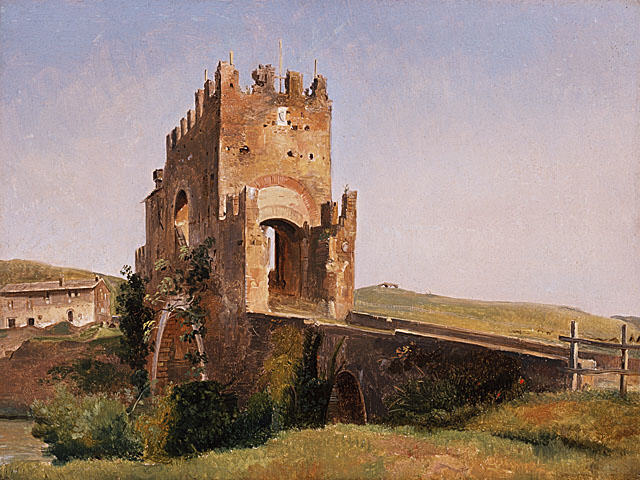
Painting by Pierre Nicolas Brisset, 1837
The most romantic of
Rome's bridges.

A foot bridge was built here by Pope Sixtus IV (hence Ponte Sisto) between 1473 and 1479 as a replacement of a prior Roman bridge named Pons Aurelius. The bridge's architectural characteristic is its central circular 'Occulus' or eye. It connects the popular night-life areas near Campo de' Fiori with Piazza Trilussa in Trastevere and has become part of popular culture and featured in films, music videos, and adverts.
Ponte
Vittorio Emanuele II
Pons Neronianus,
1911
AD
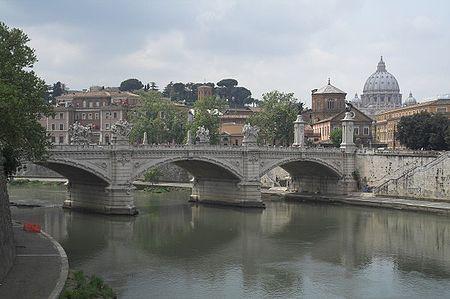
Ponte Vittorio Emanuele II was designed 1886 by the architect Ennio De Rossi. Construction was delayed, and it was not inaugurated until 1911. The bridge connects the historic centre of Rome (Corso Vittorio Emanuele and Piazza Paoli) with the Vatican City, close to the few remains of the Roman Pons Neronianus.


Sunset behind the Fascist Eagle on the Flaminian Bridge